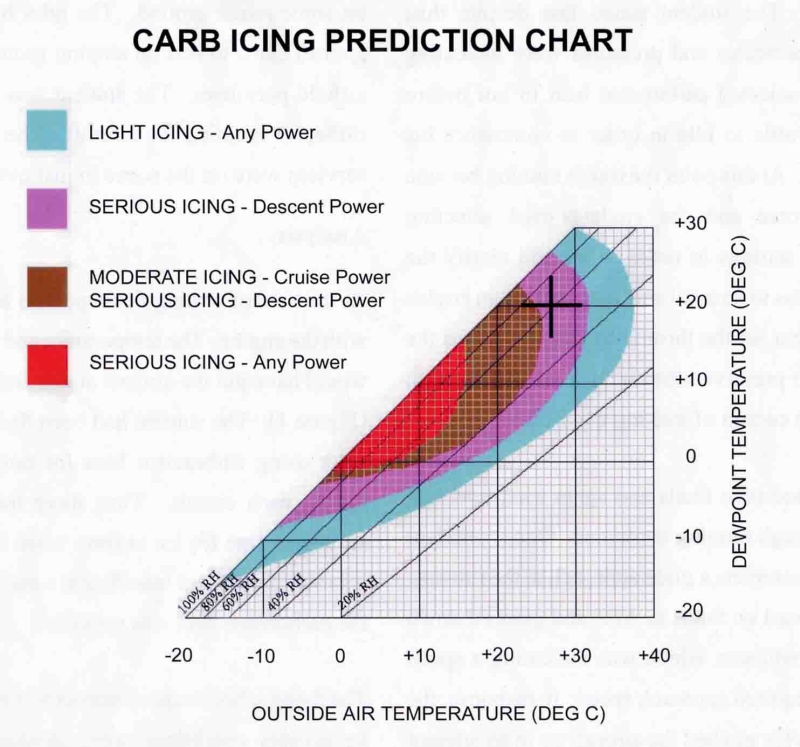Hi Folks,
This is just a reminder that carby icing can strike at any time of year, but it is most common on these cooler damper winter days. We have had a number of incidents in the past few weeks.
Did your breath generate steam this morning? Was there condensation on your car windows? Are there flickers of condensation above the wings of that airliner flying overhead? Is it misty? foggy? damp underfoot? Is there condensation on any of the Serpentine water tanks? Is there dew on the grass?
All those things mean there is a lot of humidity in the air, and it will condense and freeze in the throat of your carburettor, blocking it, and failing your engine. You do not need to know why, just accept it. This phenomenon is worst at lower power settings.
With this e-mail is a chart, published in another country, where they take carb icing more seriously.

The chart shows you how to predict carby icing. Read the outside air temperature (taken from the Jandakot ATIS, your aeroplane's OAT gauge, or your car's dashboard read-out if you are wealthy, or estimated if you're not). Run up from the bottom of the chart along that line, and where it intersects with the dewpoint (this has to come from the Jandakot or Perth ATIS, frequency 120.9, 281, Tel: 9476 8755, 123.8, 113.7, 272, Tel: 9476 8800) or you can get Jandakot (YPJT) or Perth (YPPH) actual weather reports from AOPA (even if you're not a member) on http://www.aopa.com.au/infocentre/weather.cfm.
Read the dewpoint in from the right of the chart, and where it intersects with the temperature, you can see the likelihood of carb icing. The example on the chart shows that you can get serious icing at descent power, even if the outside temperature is 27°C, provided the dewpoint is below 27°C. Be aware, if you're not already, that warm air holds a lot more moisture than cold air, so you can get nasty icing even when the OAT is in the thirties Celsius.
I'll try to remember to pin a copy of this chart up in the clubhouse some day, but meanwhile you can easily print out a copy for yourself from the attached file. Keep it in your aeroplane -- forewarned is forearmed!
Remember, it is infinitely easier to prevent carby ice than to clear it. If that great aluminium lump of a carburettor becomes cold, you are never going to heat it up again with the tiny bit of warmth retained in the thin steel or aluminium of your exhaust and carb heat shroud!
I'll tell you what I do.... Think for yourself whether or not you want to develop my habits.
I always use a long burst of carb heat immediately before taking off (thirty seconds or so) while I'm doing my pre-flight checks. Then, in the circuit, I apply full carb heat as soon as I reduce to circuit power, and leave it on all along downwind and base. I select cold air again on final, ready for the go-around.
During a cross-country, I select full carb heat (never use less than full heat -- this could actually CAUSE icing) for at least half a minute every ten minutes.
Approaching the destination, twenty seconds BEFORE I start reducing power to slow down (while there is still plenty of heat in the system) I select carb heat, and leave it on until short final.
It is important to re-select cold air if you need full power (for a touch-and-go or a go-around) otherwise you could get detonation, which can damage your engine. I open the throttle with my right thumb sticking out, so it pushes in the carby heat, just in case I've forgotten it.
If my engine does start to run roughly and I suspect I might have carby icing, I select carb heat and open the throttle fully. The engine will run roughly -- probably very roughly -- while the ice is melting and going into the cylinders. I know this contradicts what I just said about carb heat with a wide-open throttle, but once you've got carb ice, you want to get rid of it as soon as possible, and you want to survive the experience, so to hell with the engine's life expectancy.
I have been down at 300 feet in drizzle with my throttle wide open, the engine misfiring fit to jump out of the cowlings and playing the carb heat just to get it running properly again, while peering around for somewhere to land in case it didn't. It is not an experience I ever wish to repeat.
Lycomings in production aeroplanes do not suffer from a lot of carb ice, because their induction tubes go through the sump, which is full of hot oil, but until that oil's hot, or if you make a prolonged descent (over 1,000 feet) it can cool enough for ice to form.
Carburated Continentals do not have their intakes heated, so they generate a lot more ice than Lycomings. Volkswagens, with their narrow intakes, suffer from ice even more. Other automotive conversions are likely to be even worse.
I am told Jabirus and Rotaxes cannot suffer from carb ice. I have been told that injection carburettors cannot suffer from carb ice either. I have also been told that politicians never lie.
Good luck, have fun, get plenty of practice. Try not to stand your aeroplane on its nose -- it's no fun and it's expensive.
See you in a few weeks.
Yours,
Bob Grimstead
SABC Safety
